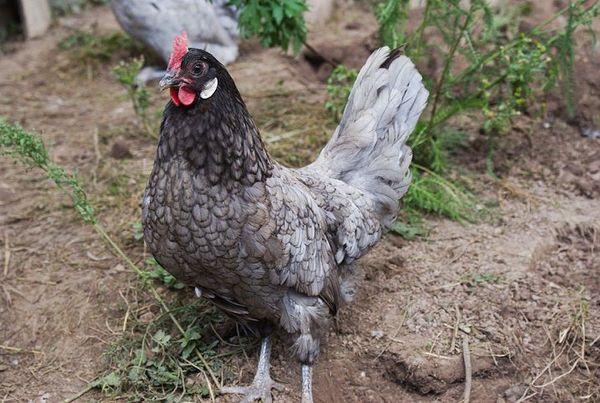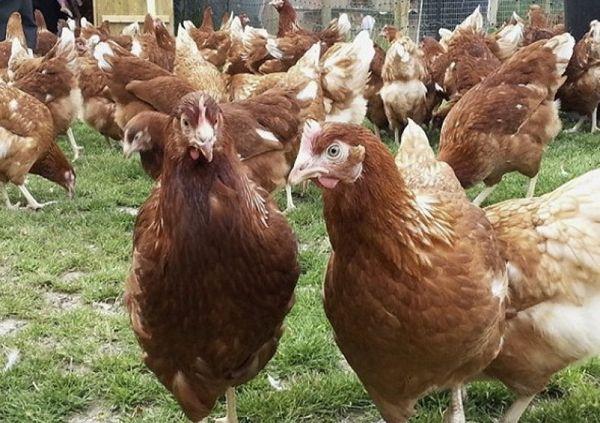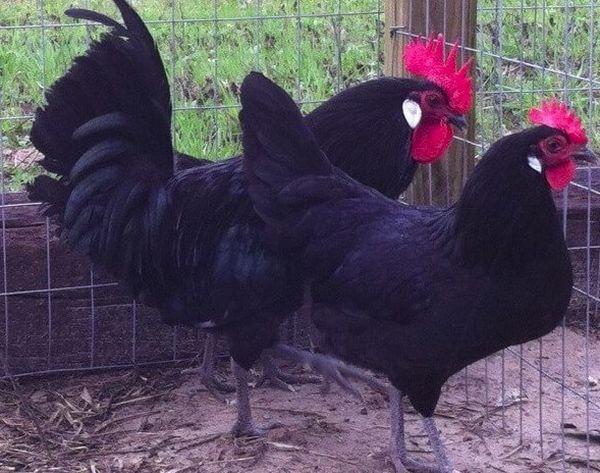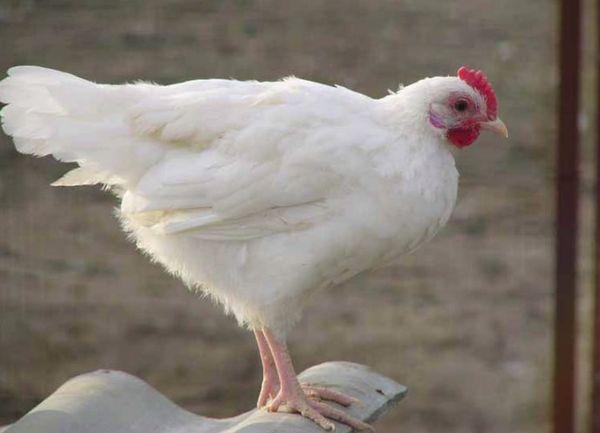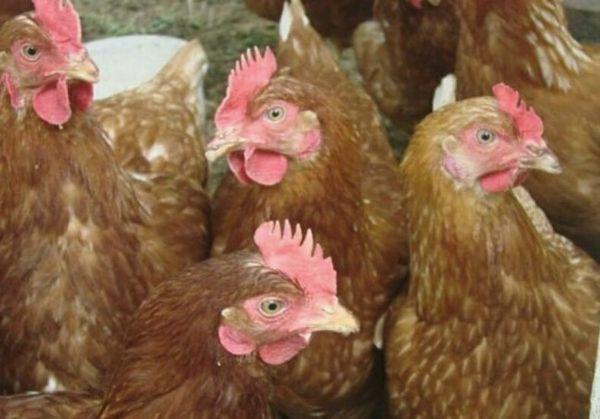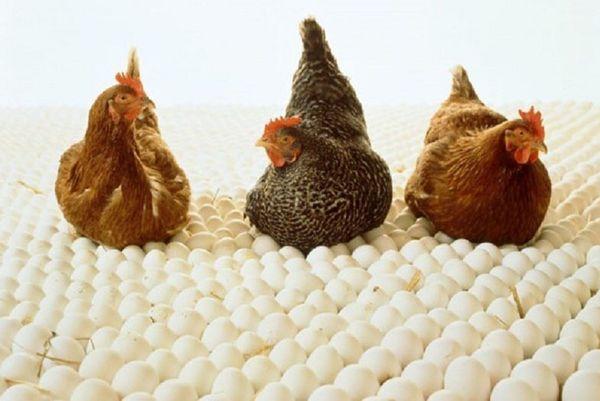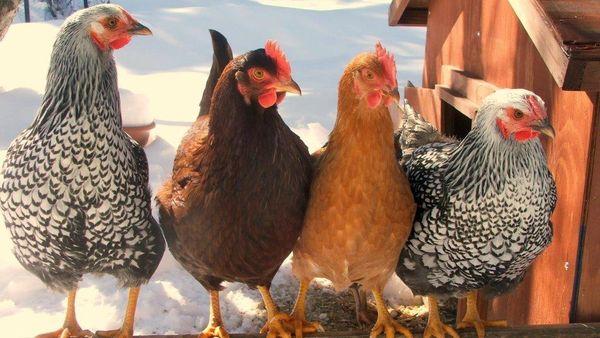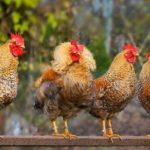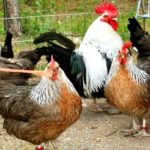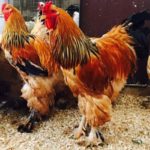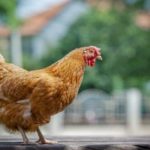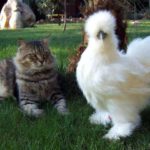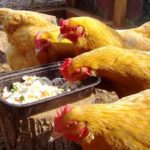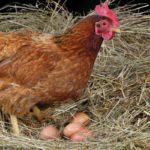Today, many people raise chickens for themselves. To choose the right breed, it is recommended to decide on its direction. There are meat, egg and meat-egg varieties of birds. People who want to get a large number of eggs should pay attention to egg hens. Below are the best breeds of laying hens for home use. Each of them is characterized by certain features.
- Features of laying hens
- Comparison of egg production of breeds
- The best breeds
- Andalusian blue
- Hamburg
- Dominant
- Isa Brown
- Kuchinskaya Yubileinaya
- Leghorn
- Loman Brown
- Minorca
- New Hampshire
- Rhode Island
- Russian white
- Tetra
- Ukrainian Ushanka
- High Line
- Hysek Brown
- Hysek White
- Shaver
- An example of a good layer
- Plumage
- Beak and legs, how to choose for beginners
- Comb and earrings of a hen and chick
- Which layer to choose?
- When is the best time to buy?
Features of laying hens
The key feature of laying hens is the ability to lay large eggs. They are edible and of high quality. This product is produced by purebred laying hens. They are characterized by common features:
- chicken body weight – no more than 2.5 kilograms;
- graceful physique;
- rapid physical growth;
- thick feathers;
- large wings;
- a long tail;
- The comb is straight and hard – it has 7 teeth.
The first clutch occurs 125 days after the chicken is born. At day 140, the hen reaches full physical development.
Comparison of egg production of breeds
The productivity of chickens is influenced by many factors. This parameter depends on the age of the bird, the characteristics of its maintenance, the climatic characteristics of the region, and the composition of the diet.
Egg production indicators, depending on the direction of the breed, are given in the table:
| Breed type | Annual parameters of egg production, pieces |
| Meat | 100-120 |
| Egg | more than 250 |
| Meat and egg | 200-240 |
The best breeds
The best breeds are obtained from a cross between different types of chickens. To choose the best option, it is worth considering the features of each of them.
Andalusian blue
This breed is considered very popular because it has a beautiful shade of feathers. Egg production parameters are considered average and reach 160-180 eggs per year. The eggs are medium in size and have a white shell.
Hamburg
These birds are often raised for ornamental purposes. They are characterized by the absence of feathers on the front of the head, white earlobes, and a raised comb. These chickens are considered small - their weight does not exceed 2.5 kilograms. Egg production parameters are rarely more than 160 pieces.The eggs are small and weigh a maximum of 55 grams.
Dominant
These birds are considered record holders for productivity. Laying hens are characterized by a massive body and many feathers. They produce up to 300 large eggs per year, weighing up to 70 grams. Laying begins early. Productivity parameters are maintained for 3-4 years.
Isa Brown
This popular egg breed was developed in France. A laying hen can produce up to 320 eggs per year. A characteristic feature is the brown tint of the shell. Chicken is highly resilient and easily adapts to any conditions.
Kuchinskaya Yubileinaya
This breed is considered universal. She produces up to 220 eggs per year, and they weigh 60 grams. A hen begins to lay eggs at six months. At the same time, it is permissible to raise the breed as a meat breed. Its weight reaches 3 kilograms and has excellent taste.
Leghorn
These birds weigh a maximum of 2 kilograms and produce up to 300 eggs per year. A characteristic feature of chickens is considered to be high endurance. Individuals quickly reach sexual maturity. They have a beautiful appearance and a characteristic leaf-shaped crest.
Loman Brown
This breed was developed in Germany, based on the rooster Plymouth rock and chickens Rhode Island. Egg production parameters reach 300-330 pieces. Chickens begin to lay eggs at the age of 130 days. Active laying lasts up to 80 days. The eggs are large in size and weigh up to 65 grams.
Minorca
These are one of the most recognizable egg-laying breeds. Chickens begin to lay eggs early - at 5 months. It will be possible to obtain up to 160 eggs weighing 56-59 grams per year. Today The Minorca is considered an endangered breed. There are several hundred such chickens in the world.
New Hampshire
This is a hybrid meat-egg breed.It was developed by American scientists. The basis was Rhode Island individuals. The key disadvantage is the low survival rate of young birds. They do not exceed 86%. Annual egg production is 200 pieces. The eggs weigh 60 grams and have a yellow-brown shell.
Rhode Island
Chickens have an attractive appearance. When raising individuals, it is important to take into account that they require mandatory walking. Keeping them in cages is prohibited. Chickens begin to lay eggs at 6 months. Average egg production is 180 pieces. The eggs weigh 62 grams and have a brown shell.
Russian white
This breed is included in the ranking of the most popular egg varieties. Individuals are perfectly adapted to Russian conditions. Laying hen eggs weigh about 55 grams.
Tetra
This is one of the most productive crosses, which is why it is often chosen for home keeping. The bird brings up to 310 eggs per year. They reach a weight of 65 grams. The first clutch occurs at 21 weeks of life.
Ukrainian Ushanka
This breed is considered meat-eating. It was developed back in the seventeenth century. A characteristic feature is the tufts of feathers that grow in the area of the ear openings. Chickens are easy to care for and have good productivity. Laying hens gain weight every day and weigh up to 2.3 kilograms. They produce 160 eggs per year.
High Line
These chickens are characterized by high productivity. When a bird reaches 80 weeks of age, it produces 350 large eggs. The advantage of the breed is its unpretentiousness to living conditions.
Hysek Brown
This breed is excellent for breeding. It produces large eggs that reach 60 grams. The egg production parameters per year are 300 pieces.The advantage of birds is considered to be their high resistance to infections, fungi, and helminthic infestations.
Hysek White
These birds are also characterized by high productivity. They differ from the previous breed only in the shade of their plumage. These chickens are characterized by snow-white feathers.
Shaver
Chickens of this breed produce a lot of eggs. Egg production parameters reach 235 eggs per year. Laying hens produce the most eggs at 27-46 weeks of life. Their weight is 63 grams.
An example of a good layer
When choosing a laying hen, you should immediately avoid buying birds with physical defects. These include deformed fingers or keel, and an irregularly shaped beak. The following features indicate the high productivity of chicken:
- high physical activity;
- a good appetite;
- long and wide body;
- well developed breasts;
- strong, widely spaced legs.
Too much or too little protein in a chicken's diet will often cause it to fall on its feet. This will have a negative impact on productivity later on.
Plumage
The productivity of a laying hen can be assessed by its feathers. A healthy individual has dense and shiny plumage. An unproductive chicken is distinguished by dull and loose feathers.
Molting also indicates egg production. Productive individuals lay eggs for a long time, and therefore shed their feathers in October-November. At this time, they become unattractive, so inexperienced poultry farmers often discard such individuals.
Unproductive laying hens begin to molt as early as July-August. Moreover, this process lasts 4 months. However, by the time the flock begins to form, such chickens look more attractive. Therefore, they are often mistakenly given preference.
The number of flight feathers on the wings is of no small importance.Good layers have quite a lot of them.
Beak and legs, how to choose for beginners
The shade of the beak, iris and paws helps determine the productivity of chickens. When buying remontant young animals, you should pay attention to the yellow tint of the legs, irises and beak. As performance increases, the pigmentation gradually disappears. The higher the productivity of the chicken, the faster this process occurs.
First, pigmentation disappears from the iris. Then the beak and paws are involved in the process. Therefore, birds with good egg production are not as brightly pigmented in the fall as unproductive layers.
It is also worth considering that it is not recommended to leave young animals with deformed legs. This feature is inherited and provokes a decrease in productivity parameters.
Comb and earrings of a hen and chick
Chickens with pale or overdeveloped combs are not suitable for the formation of livestock. Pale and wrinkled earrings and comb indicate low egg production of the individual. In productive birds they have a scarlet or red tint and a warm and elastic consistency.
Which layer to choose?
For household purposes, birds are often purchased at the market or poultry farm. When purchasing an individual from farmers, it is worth asking questions regarding the breed and living conditions. Most chickens purchased from farmers are considered winter-hardy and produce large eggs.
However, it is important to check birds for diseases. Not all farmers are conscientious and can sell bad laying hens to inexperienced people for personal farming.
When purchasing new chickens from a poultry farm, you can be sure that they are vaccinated. However, it is difficult to breed such birds at home.They are characterized by poor immunity and have difficulty adapting to new conditions.
When is the best time to buy?
Young animals 4-5 months old should be purchased in spring and autumn. If you do this in the spring, their egg production will peak by summer. In the fall it is worth renewing the livestock. For this purpose, good laying hens are left for the winter, and bad ones are used for meat. It is recommended to purchase several new chickens.
There are many breeds of chickens that are suitable for small-scale farming. When choosing a specific individual, you should focus on egg production parameters and take into account the care requirements. It is better for beginning farmers to choose unpretentious breeds.

